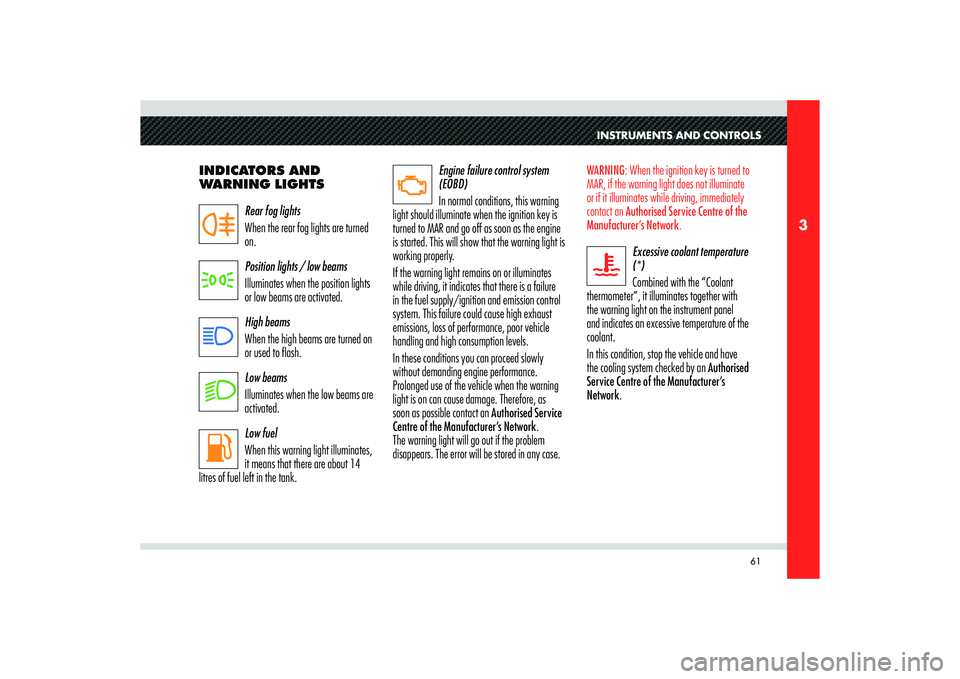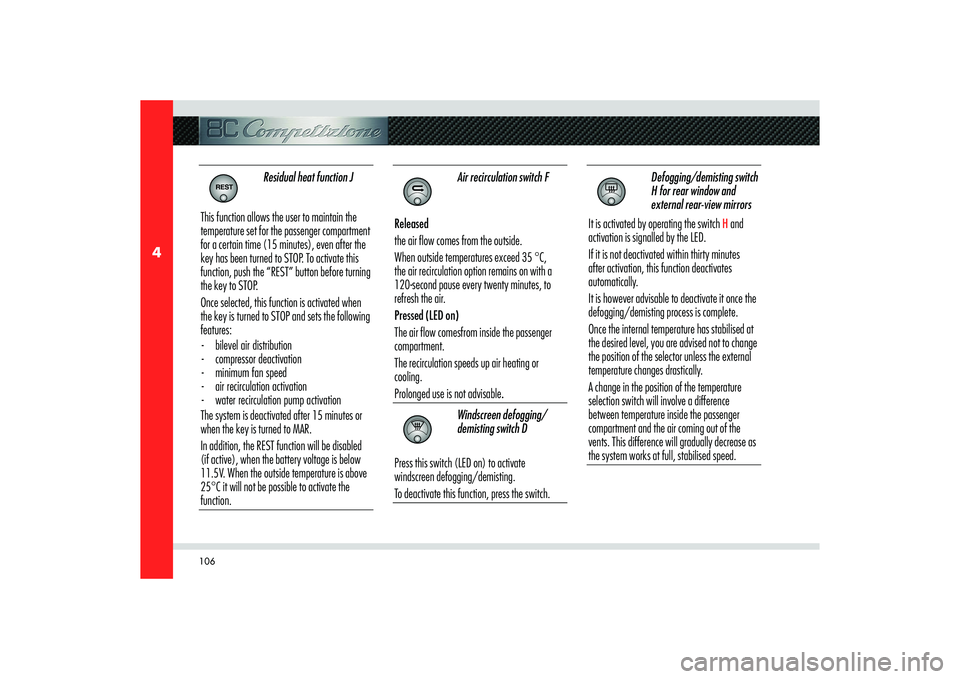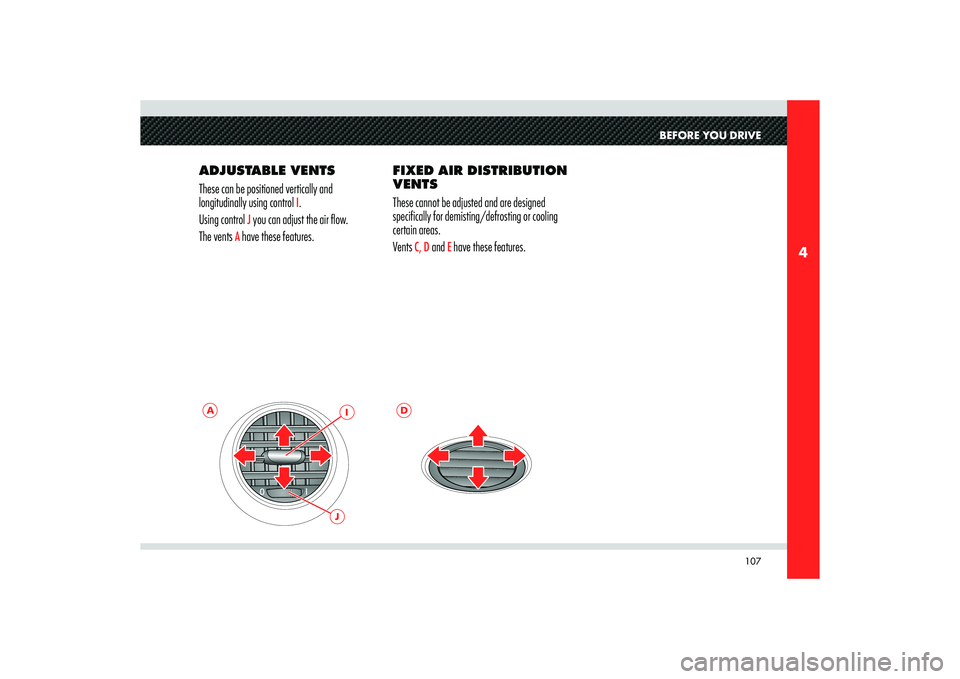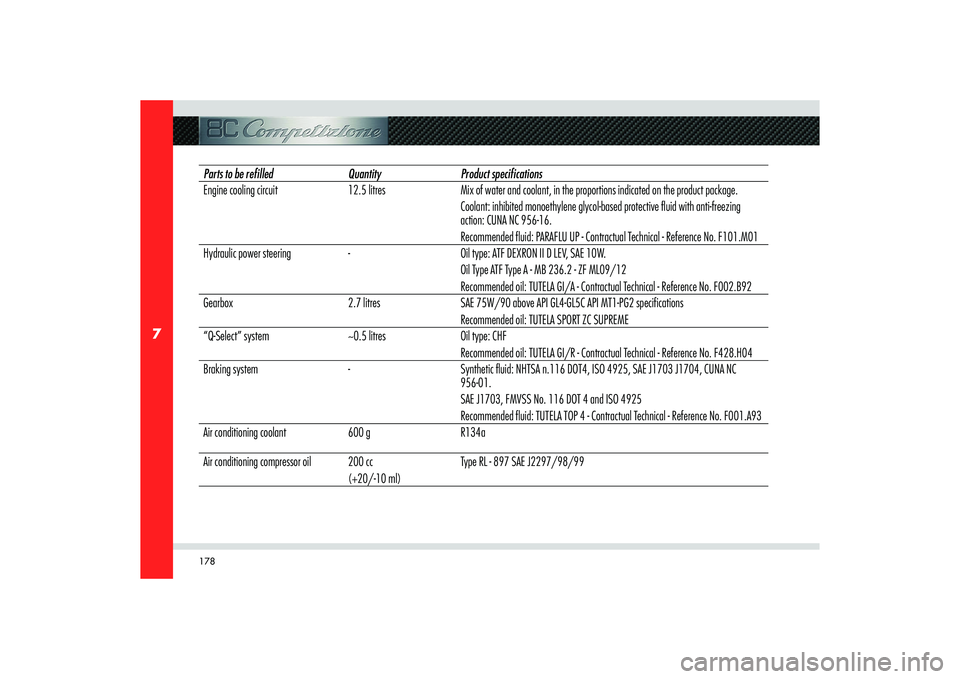cooling Alfa Romeo 8C 2007 Owner handbook (in English)
[x] Cancel search | Manufacturer: ALFA ROMEO, Model Year: 2007, Model line: 8C, Model: Alfa Romeo 8C 2007Pages: 223, PDF Size: 14.35 MB
Page 63 of 223

61
3
INSTRUMENTS AND CONTROLSWARNING: When the ignition key is turned to
MAR, if the warning light does not illuminate
or if it illuminates while driving, immediately
contact an Authorised Service Centre of the
Manufacturer’s Network.
Excessive coolant temperature
(*)
Combined with the “Coolant
thermometer”, it illuminates together with
the warning light on the instrument panel
and indicates an excessive temperature of the
coolant.
In this condition, stop the vehicle and have
the cooling system checked by an Authorised
Service Centre of the Manufacturer’s
Network. INDICATORS AND
WARNING LIGHTS
Rear fog lights
When the rear fog lights are turned
on.
Position lights / low beams
Illuminates when the position lights
or low beams are activated.
High beams
When the high beams are turned on
or used to flash.
Low beams
Illuminates when the low beams are
activated.
Low fuel
When this warning light illuminates,
it means that there are about 14
litres of fuel left in the tank.Engine failure control system
(EOBD)
In normal conditions, this warning
light should illuminate when the ignition key is
turned to MAR and go off as soon as the engine
is started. This will show that the warning light is
working properly.
If the warning light remains on or illuminates
while driving, it indicates that there is a failure
in the fuel supply/ignition and emission control
system. This failure could cause high exhaust
emissions, loss of performance, poor vehicle
handling and high consumption levels.
In these conditions you can proceed slowly
without demanding engine performance.
Prolonged use of the vehicle when the warning
light is on can cause damage. Therefore, as
soon as possible contact an Authorised Service
Centre of the Manufacturer’s Network.
The warning light will go out if the problem
disappears. The error will be stored in any case.
Page 108 of 223

106
4
Residual heat function J
This function allows the user to maintain the
temperature set for the passenger compartment
for a certain time (15 minutes), even after the
key has been turned to STOP. To activate this
function, push the “REST” button before turning
the key to STOP.
Once selected, this function is activated when
the key is turned to STOP and sets the following
features:
- bilevel air distribution
- compressor deactivation
- minimum fan speed
- air recirculation activation
- water recirculation pump activation
The system is deactivated after 15 minutes or
when the key is turned to MAR.
In addition, the REST function will be disabled
(if active), when the battery voltage is below
11.5V. When the outside temperature is above
25°C it will not be possible to activate the
function.
Air recirculation switch F
Released
the air flow comes from the outside.
When outside temperatures exceed 35 °C,
the air recirculation option remains on with a
120-second pause every twenty minutes, to
refresh the air.
Pressed (LED on)
The air flow comesfrom inside the passenger
compartment.
The recirculation speeds up air heating or
cooling.
Prolonged use is not advisable.
Windscreen defogging/
demisting switch D
Press this switch (LED on) to activate
windscreen defogging/demisting.
To deactivate this function, press the switch.
Defogging/demisting switch
H for rear window and
external rear-view mirrors
It is activated by operating the switch
H and
activation is signalled by the LED.
If it is not deactivated within thirty minutes
after activation, this function deactivates
automatically.
It is however advisable to deactivate it once the
defogging/demisting process is complete.
Once the internal temperature has stabilised at
the desired level, you are advised not to change
the position of the selector unless the external
temperature changes drastically.
A change in the position of the temperature
selection switch will involve a difference
between temperature inside the passenger
compartment and the air coming out of the
vents. This difference will gradually decrease as
the system works at full, stabilised speed.
Page 109 of 223

107
4
D
I
A
J
BEFORE YOU DRIVE
ADJUSTABLE VENTS
These can be positioned vertically and
longitudinally using control
I.
Using control
J you can adjust the air flow.
The vents
A have these features.FIXED AIR DISTRIBUTION
VENTS
These cannot be adjusted and are designed
specifically for demisting/defrosting or cooling
certain areas.
Vents
C, D and
E have these features.
Page 180 of 223

178
7
Parts to be refi lled Quantity Product specifi cations
Engine cooling circuit 12.5 litres Mix of water and coolant, in the proportions indicated on the product package.
Coolant: inhibited monoethylene glycol-based protective fluid with anti-freezing
action: CUNA NC 956-16.
Recommended fluid: PARAFLU UP - Contractual Technical - Reference No. F101.M01
Hydraulic power steering - Oil type: ATF DEXRON II D LEV, SAE 10W.
Oil Type ATF Type A - MB 236.2 - ZF ML09/12
Recommended oil: TUTELA GI/A - Contractual Technical - Reference No. F002.B92
Gearbox 2.7 litres SAE 75W/90 above API GL4-GL5C API MT1-PG2 specifications
Recommended oil: TUTELA SPORT ZC SUPREME
“Q-Select” system ~0.5 litres Oil type: CHF
Recommended oil: TUTELA GI/R - Contractual Technical - Reference No. F428.H04
Braking system - Synthetic fluid: NHTSA n.116 DOT4, ISO 4925, SAE J1703 J1704, CUNA NC
956-01.
SAE J1703, FMVSS No. 116 DOT 4 and ISO 4925
Recommended fluid: TUTELA TOP 4 - Contractual Technical - Reference No. F001.A93
Air conditioning coolant 600 g R134a
Air conditioning compressor oil 200 cc
(+20/-10 ml)Type RL - 897 SAE J2297/98/99
Page 183 of 223

181
7
CAPACITIES AND TECHNICAL SPECIFICATIONS
LUBRICATION SYSTEM
The lubrication system uses a wet sump system
and oil pump with the relative suction screen,
incorporated in the crankcase.TRANSMISSION
Clutch
Dry double-plate clutch with servo-assisted
hydraulic control. COOLING SYSTEM
Engine cooling is obtained by means of an anti-
freeze mixture circulating inside a system with
radiator, centrifugal pump and expansion tank.
Page 209 of 223

207
8
MAINTENANCE
the Authorised Service Centres of the
Manufacturer’s Network). Do not use
thick plastic sheets, which do not allow
the humidity on the vehicle surface to
evaporate.
- Infl ate the tyres up to a pressure which
must be 0.5 bar higher than the normally
prescribed one, and check it at regular
intervals.
CAUTION
The tyre pressure must be
brought back to the prescribed value
before reusing the vehicle.
- Do not drain the engine cooling system. BATTERY CONDITIONER
SOCKET
Located under the left-hand seat, it can be
accessed by moving the seat forward and folding
down the backrest.
IF THE VEHICLE
IS LAID UP FOR
LONG PERIODS- If the vehicle is not used for several months,
take the following precautions:
- Wash and dry the vehicle thoroughly.
- Store the vehicle in a covered, dry and, if
possible, ventilated area.
- Engage a gear.
- Disconnect the battery (see page 168).
- Check the battery charge condition. This
check should be carried out monthly while
the vehicle is idle. Recharge the battery if
the load-free voltage is below 12.5 V.
- Check that the electric parking brake is not
applied.
- Clean and protect the painted parts applying
protective waxes.
- Clean and protect polished metal parts with
specifi c products available on the market.
- Talc the windscreen wiper blades and raise
them from the windscreen.
- Cover the vehicle with a fabric sheet
to allow transpiration (available at all
Page 221 of 223

219
9
TABLE OF CONTENTS
If there are injured persons ............................ 171
First aid kit .................................................. 172
Capacities and technical specifi cations ...... 175
Fuel ................................................................176
Engine oil ........................................................176
Capacities: quantity and speci� cations of the
products to use .............................................177
Capacities and recommended products ............. 177
Fuel consumption .............................................179
Fuel consumption following the 2004/3/EC
directive (litres per 100 km) ....................... 179
CO2 exhaust emissions .....................................179
CO2 emissions according to Directive
2002/80B/EC (g/km) ............................ 179
Technical speci� cations .....................................180
Engine ........................................................ 180
Injection – Ignition ....................................... 180
Lubrication system ....................................... 181
Cooling system ............................................ 181
Transmission ................................................ 181
Gearshifting ................................................. 182
Brakes ........................................................ 182
Suspension ................................................. 183
Steering ...................................................... 183
Wheels ....................................................... 183
Performance ................................................ 184Weights ...................................................... 184
Dimensions ................................................ 185
Tyre pressure ...................................................186
Maintenance .......................................... 189
Scheduled Maintenance ....................................190
After the 11
th service ................................... 190
Additional checks .............................................192
WARNING - Engine oil .................................... 192
WARNING - Air fi lter ..................................... 192
Level checks ....................................................193
Engine oil .................................................... 194
Gearbox oil ................................................. 195
Engine coolant ............................................. 195
Windscreen/headlight washer fl uid ................. 195
Power steering fl uid ...................................... 196
Brake fl uid ................................................. 196
Air � lter ..........................................................197
Anti-dust/anti-pollen � lter ...............................197
Battery ............................................................198
Useful hints for extending the life
of the battery ........................................... 198
Electronic control units .....................................199
Spark plugs .....................................................200
Wheels and tyres .............................................200
How to use the tyres .................................... 201Windscreen wipers ...........................................202
Spray nozzles .............................................. 203
Replacing the wiper blades ............................ 203
Air conditioning/heating system .......................203
Bodywork ........................................................204
Protection from atmospheric agents ................ 204
Tips for keeping the bodywork in good
condition .................................................. 204
Engine compartment ..................................... 205
Interiors ..........................................................206
Cleaning the leather upholstery ...................... 206
Leather upholstery treatment ......................... 206
Carbon parts ................................................ 206
If the vehicle is laid up for long periods ............207
Battery conditioner socket ............................. 207
Restarting the vehicle .................................... 210
Re-connecting the battery .............................. 211
Radio-frequency remote control: Ministerial
homologation ..............................................211
Conversion table ..............................................212
Table of contents .................................... 215
Table of contents ..............................................216